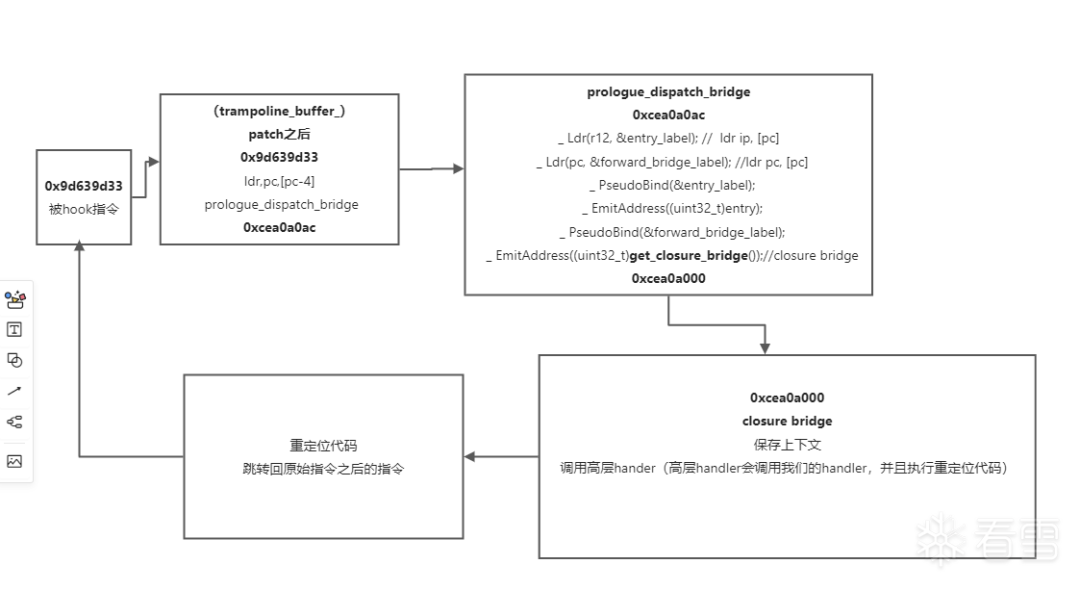
This article is an excellent piece from the KX forum.
KX Forum Author ID: KerryS
Dobby has two main functions: one is inline hooking, and the other is instruction instrumentation. The principles of both are similar, but this article mainly introduces instruction instrumentation.
int res_instument = DobbyInstrument((void *) addr, offset_name_handler); // handler is our custom callback // RegisterContext is the register context, HookEntryInfo contains necessary information for the hook, such as hook address, etc. void offset_name_handler(RegisterContext *ctx, const HookEntryInfo *info) typedef struct _RegisterContext { uint32_t dummy_0; uint32_t dummy_1; uint32_t dummy_2; uint32_t sp; union { uint32_t r[13]; struct { uint32_t r0, r1, r2, r3, r4, r5, r6, r7, r8, r9, r10, r11, r12; } regs; } general; uint32_t lr; } RegisterContext; // HookEntryInfo contains hook address and ID typedef struct _HookEntryInfo { int hook_id; union { void *target_address; void *function_address; void *instruction_address; }; } HookEntryInfo;一
工作原理

------------------------------------------------------------------------------process 60890x9d639d32 nop0x9d639d34 ldr.w pc, [pc, #-0x0]0x9d639d38 // Address 0xcea0a0ac0x9d639d38 0 1 2 3 4 5 6 7 8 9 A B C D E F 0123456789ABCDEF00000000 ac a0 a0 ce ....------------------------------------------------------------------------------0xcea0a0ac ldr ip, [pc]0xcea0a0b0 ldr pc, [pc]0xcea0a0b4 // Address 0xa2305b800xcea0a0b8 // Address 0xcea0a0000xcea0a0b4 0 1 2 3 4 5 6 7 8 9 A B C D E F 0123456789ABCDEF00000000 80 5b 30 a2 00 a0 a0 ce0xcea0a000 sub sp, sp, #0x380xcea0a004 str lr, [sp, #0x34]0xcea0a008 str ip, [sp, #0x30]0xcea0a00c str fp, [sp, #0x2c]0xcea0a010 str sl, [sp, #0x28]0xcea0a014 str sb, [sp, #0x24]0xcea0a018 str r8, [sp, #0x20]0xcea0a01c str r7, [sp, #0x1c]0xcea0a020 str r6, [sp, #0x18]0xcea0a024 str r5, [sp, #0x14]0xcea0a028 str r4, [sp, #0x10]0xcea0a02c str r3, [sp, #0xc]0xcea0a030 str r2, [sp, #8]0xcea0a034 str r1, [sp, #4]0xcea0a038 str r0, [sp]0xcea0a03c add r0, sp, #0x380xcea0a040 sub sp, sp, #80xcea0a044 str r0, [sp, 4]0xcea0a048 sub sp, sp, #80xcea0a04c mov r0, sp0xcea0a050 mov r1, ip0xcea0a054 bl #0xcea0a05c0xcea0a058 b #0xcea0a0640xcea0a05c ldr pc, [pc, #-4]0xcea0a060 // Address 0x9d2b43e10xcea0a060 0 1 2 3 4 5 6 7 8 9 A B C D E F 0123456789ABCDEF00000000 e1 43 2b 9dvoid instrument_call_forward_handler(RegisterContext *ctx, HookEntry *entry) { DynamicBinaryInstrumentRouting *route = (DynamicBinaryInstrumentRouting *)entry->route; if (route->handler) { DBICallTy handler; HookEntryInfo entry_info; entry_info.hook_id = entry->id; entry_info.instruction_address = entry->instruction_address; handler = (DBICallTy)route->handler; (*handler)(ctx, (const HookEntryInfo *)&entry_info); } // set prologue bridge next hop address with origin instructions that have been relocated(patched) set_routing_bridge_next_hop(ctx, entry->relocated_origin_instructions);}0xcea0a064 add sp, sp, #80xcea0a068 add sp, sp, #80xcea0a06c pop {r0}0xcea0a070 pop {r1}0xcea0a074 pop {r2}0xcea0a078 pop {r3}0xcea0a07c pop {r4}0xcea0a080 pop {r5}0xcea0a084 pop {r6}0xcea0a088 pop {r7}0xcea0a08c pop {r8}0xcea0a090 pop {sb}0xcea0a094 pop {sl}0xcea0a098 pop {fp}0xcea0a09c pop {ip}0xcea0a0a0 pop {lr}0xcea0a0a4 mov pc, ip// set prologue bridge next hop address with origin instructions that have been relocated(patched) set_routing_bridge_next_hop(ctx, entry->relocated_origin_instructions); void set_routing_bridge_next_hop(RegisterContext *ctx, void *address) { *reinterpret_cast<void **>(&ctx->general.regs.r12) = address;}
------------------------------------------------------------------------------process 60890xcea0a0c0 nop0xcea0a0c2 nop0xcea0a0c4 push {r0, r1, r2, lr}0xcea0a0c6 nop0xcea0a0c8 cbz r0, #0xcea0a0cc0xcea0a0ca nop0xcea0a0cc b.w #0xcea0a0d00xcea0a0d0 ldr.w pc, [pc, #0x14] 0xcea0a0d0 + 0x14+thumb_pc_offset(4)=0xcea0a0e8,即 0x9d639d450xcea0a0d4 nop0xcea0a0d6 nop0xcea0a0d8 add r2, sp, #80xcea0a0da nop0xcea0a0dc str r1, [r2, #-0x4]!0xcea0a0e0 ldr.w pc, [pc, #-0x0] 同理,0x9d639d3d0xcea0a0e4 // Address 0x9d639d3d0xcea0a0e8 // Address 0x9d639d450xcea0a0e4 0 1 2 3 4 5 6 7 8 9 A B C D E F 0123456789ABCDEF00000000 3d 9d 63 9d 45 9d 63 9d =.c.E.c.------------------------------------------------------------------------------二
代码详解
void DynamicBinaryInstrumentRouting::DispatchRouting() { BuildDynamicBinaryInstrumentRouting(); // generate relocated code which size == trampoline size GenerateRelocatedCode(trampoline_buffer_->getSize());}BuildDynamicBinaryInstrumentRouting()
void DynamicBinaryInstrumentRouting::BuildDynamicBinaryInstrumentRouting() { // create closure trampoline jump to prologue_routing_dispath with the `entry_` data ClosureTrampolineEntry *closure_trampoline; void *handler = (void *)instrument_routing_dispatch;#if __APPLE__#if __has_feature(ptrauth_calls) handler = __builtin_ptrauth_strip(handler, ptrauth_key_asia);#endif#endif closure_trampoline = ClosureTrampoline::CreateClosureTrampoline(entry_, handler); this->SetTrampolineTarget(closure_trampoline->address); DLOG(0, "[closure bridge] Carry data %p ", entry_); DLOG(0, "[closure bridge] Create prologue_dispatch_bridge %p", closure_trampoline->address); // generate trampoline buffer, run before `GenerateRelocatedCode` GenerateTrampolineBuffer(entry_->target_address, GetTrampolineTarget());}ClosureTrampolineEntry *ClosureTrampoline::CreateClosureTrampoline(void *carry_data, void *carry_handler) { ClosureTrampolineEntry *entry = nullptr; entry = new ClosureTrampolineEntry; #ifdef ENABLE_CLOSURE_TRAMPOLINE_TEMPLATE#define CLOSURE_TRAMPOLINE_SIZE (7 * 4) // use closure trampoline template code, find the executable memory and patch it. Code *code = Code::FinalizeCodeFromAddress(closure_trampoline_template, CLOSURE_TRAMPOLINE_SIZE);#else // use assembler and codegen modules instead of template_code#include "TrampolineBridge/ClosureTrampolineBridge/AssemblyClosureTrampoline.h"#define _ turbo_assembler_. TurboAssembler turbo_assembler_(0); PseudoLabel entry_label; PseudoLabel forward_bridge_label; _ Ldr(r12, &entry_label); _ Ldr(pc, &forward_bridge_label); _ PseudoBind(&entry_label); _ EmitAddress((uint32_t)entry); _ PseudoBind(&forward_bridge_label); _ EmitAddress((uint32_t)get_closure_bridge()); AssemblyCodeChunk *code = nullptr; code = AssemblyCodeBuilder::FinalizeFromTurboAssembler(&turbo_assembler_); entry->address = (void *)code->raw_instruction_start(); entry->size = code->raw_instruction_size(); entry->carry_data = carry_data; entry->carry_handler = carry_handler; delete code; return entry;#endif}void *get_closure_bridge() { // if already initialized, just return. if (closure_bridge) return closure_bridge; // check if enable the inline-assembly closure_bridge_template#if ENABLE_CLOSURE_BRIDGE_TEMPLATE extern void closure_bridge_tempate(); closure_bridge = closure_bridge_template;// otherwise, use the Assembler build the closure_bridge#else#define _ turbo_assembler_. TurboAssembler turbo_assembler_(0, code_buffer); _ sub(sp, sp, Operand(14 * 4)); _ str(lr, MemOperand(sp, 13 * 4)); _ str(r12, MemOperand(sp, 12 * 4)); _ str(r11, MemOperand(sp, 11 * 4)); _ str(r10, MemOperand(sp, 10 * 4)); _ str(r9, MemOperand(sp, 9 * 4)); _ str(r8, MemOperand(sp, 8 * 4)); _ str(r7, MemOperand(sp, 7 * 4)); _ str(r6, MemOperand(sp, 6 * 4)); _ str(r5, MemOperand(sp, 5 * 4)); _ str(r4, MemOperand(sp, 4 * 4)); _ str(r3, MemOperand(sp, 3 * 4)); _ str(r2, MemOperand(sp, 2 * 4)); _ str(r1, MemOperand(sp, 1 * 4)); _ str(r0, MemOperand(sp, 0 * 4)); // store sp _ add(r0, sp, Operand(14 * 4)); _ sub(sp, sp, Operand(8)); _ str(r0, MemOperand(sp, 4)); // stack align _ sub(sp, sp, Operand(8)); _ mov(r0, Operand(sp)); _ mov(r1, Operand(r12)); _ CallFunction(ExternalReference((void *)intercept_routing_common_bridge_handler)); // stack align _ add(sp, sp, Operand(8)); // restore sp placeholder stack _ add(sp, sp, Operand(8)); _ ldr(r0, MemOperand(sp, 4, PostIndex)); _ ldr(r1, MemOperand(sp, 4, PostIndex)); _ ldr(r2, MemOperand(sp, 4, PostIndex)); _ ldr(r3, MemOperand(sp, 4, PostIndex)); _ ldr(r4, MemOperand(sp, 4, PostIndex)); _ ldr(r5, MemOperand(sp, 4, PostIndex)); _ ldr(r6, MemOperand(sp, 4, PostIndex)); _ ldr(r7, MemOperand(sp, 4, PostIndex)); _ ldr(r8, MemOperand(sp, 4, PostIndex)); _ ldr(r9, MemOperand(sp, 4, PostIndex)); _ ldr(r10, MemOperand(sp, 4, PostIndex)); _ ldr(r11, MemOperand(sp, 4, PostIndex)); _ ldr(r12, MemOperand(sp, 4, PostIndex)); _ ldr(lr, MemOperand(sp, 4, PostIndex)); // auto switch A32 & T32 with `least significant bit`, refer `docs/A32_T32_states_switch.md` _ mov(pc, Operand(r12)); AssemblyCodeChunk *code = AssemblyCodeBuilder::FinalizeFromTurboAssembler(&turbo_assembler_); closure_bridge = (void *)code->raw_instruction_start(); DLOG(0, "[closure bridge] Build the closure bridge at %p", closure_bridge);#endif return (void *)closure_bridge;}bool InterceptRouting::GenerateTrampolineBuffer(void *src, void *dst) { CodeBufferBase *trampoline_buffer = NULL; // if near branch trampoline plugin enabled if (RoutingPluginManager::near_branch_trampoline) { RoutingPluginInterface *plugin = NULL; plugin = reinterpret_cast<RoutingPluginInterface *>(RoutingPluginManager::near_branch_trampoline); if (plugin->GenerateTrampolineBuffer(this, src, dst) == false) { DLOG(0, "Failed enable near branch trampoline plugin"); } } if (this->GetTrampolineBuffer() == NULL) { trampoline_buffer = GenerateNormalTrampolineBuffer((addr_t)src, (addr_t)dst); this->SetTrampolineBuffer(trampoline_buffer); DLOG(0, "[trampoline] Generate trampoline buffer %p -> %p", src, dst); } return true;}GenerateRelocatedCode(trampolinebuffer->getSize())
bool InterceptRouting::GenerateRelocatedCode(int tramp_size) { // generate original code AssemblyCodeChunk *origin = NULL; origin = AssemblyCodeBuilder::FinalizeFromAddress((addr_t)entry_->target_address, tramp_size); origin_ = origin; // generate the relocated code AssemblyCodeChunk *relocated = NULL; relocated = AssemblyCodeBuilder::FinalizeFromAddress(0, 0); relocated_ = relocated; void *relocate_buffer = NULL; relocate_buffer = entry_->target_address; GenRelocateCodeAndBranch(relocate_buffer, origin, relocated); if (relocated->raw_instruction_start() == 0) return false; // set the relocated instruction address entry_->relocated_origin_instructions = (void *)relocated->raw_instruction_start(); DLOG(0, "[insn relocate] origin %p - %d", origin->raw_instruction_start(), origin->raw_instruction_size()); DLOG(0, "[insn relocate] relocated %p - %d", relocated->raw_instruction_start(), relocated->raw_instruction_size()); // save original prologue memcpy((void *)entry_->origin_chunk_.chunk_buffer, (void *)origin->raw_instruction_start(), origin->raw_instruction_size()); entry_->origin_chunk_.chunk.re_init_region_range(origin_); return true;}void GenRelocateCodeAndBranch(void *buffer, AssemblyCodeChunk *origin, AssemblyCodeChunk *relocated) { CodeBuffer *code_buffer = new CodeBuffer(64); ThumbTurboAssembler thumb_turbo_assembler_(0, code_buffer);#define thumb_ thumb_turbo_assembler_. TurboAssembler arm_turbo_assembler_(0, code_buffer);#define arm_ arm_turbo_assembler_. Assembler *curr_assembler_ = NULL; AssemblyCodeChunk origin_chunk; origin_chunk.init_region_range(origin->raw_instruction_start(), origin->raw_instruction_size()); bool entry_is_thumb = origin->raw_instruction_start() % 2; if (entry_is_thumb) { origin->re_init_region_range(origin->raw_instruction_start() - THUMB_ADDRESS_FLAG, origin->raw_instruction_size()); } LiteMutableArray relo_map(8); relocate_remain: addr32_t execute_state_changed_pc = 0; bool is_thumb = origin_chunk.raw_instruction_start() % 2; if (is_thumb) { curr_assembler_ = &thumb_turbo_assembler_; buffer = (void *)((addr_t)buffer - THUMB_ADDRESS_FLAG); addr32_t origin_code_start_aligned = origin_chunk.raw_instruction_start() - THUMB_ADDRESS_FLAG; // remove thumb address flag origin_chunk.re_init_region_range(origin_code_start_aligned, origin_chunk.raw_instruction_size()); gen_thumb_relocate_code(&relo_map, &thumb_turbo_assembler_, buffer, &origin_chunk, relocated, &execute_state_changed_pc); if (thumb_turbo_assembler_.GetExecuteState() == ARMExecuteState) { // relocate interrupt as execute state changed if (execute_state_changed_pc < origin_chunk.raw_instruction_start() + origin_chunk.raw_instruction_size()) { // re-init the origin int relocate_remain_size = origin_chunk.raw_instruction_start() + origin_chunk.raw_instruction_size() - execute_state_changed_pc; // current execute state is ARMExecuteState, so not need `+ THUMB_ADDRESS_FLAG` origin_chunk.re_init_region_range(execute_state_changed_pc, relocate_remain_size); // update buffer buffer = (void *)((addr_t)buffer + (execute_state_changed_pc - origin_code_start_aligned)); // add nop to align ARM if (thumb_turbo_assembler_.pc_offset() % 4) thumb_turbo_assembler_.t1_nop(); goto relocate_remain; } } } else { curr_assembler_ = &arm_turbo_assembler_; gen_arm_relocate_code(&relo_map, &arm_turbo_assembler_, buffer, &origin_chunk, relocated, &execute_state_changed_pc); if (arm_turbo_assembler_.GetExecuteState() == ThumbExecuteState) { // relocate interrupt as execute state changed if (execute_state_changed_pc < origin_chunk.raw_instruction_start() + origin_chunk.raw_instruction_size()) { // re-init the origin int relocate_remain_size = origin_chunk.raw_instruction_start() + origin_chunk.raw_instruction_size() - execute_state_changed_pc; // current execute state is ThumbExecuteState, add THUMB_ADDRESS_FLAG origin_chunk.re_init_region_range(execute_state_changed_pc + THUMB_ADDRESS_FLAG, relocate_remain_size); // update buffer buffer = (void *)((addr_t)buffer + (execute_state_changed_pc - origin_chunk.raw_instruction_start())); goto relocate_remain; } } } // TODO: // if last instr is unlink branch, skip //dkl 调回插桩点之后继续执行 addr32_t rest_instr_addr = origin_chunk.raw_instruction_start() + origin_chunk.raw_instruction_size(); if (curr_assembler_ == &thumb_turbo_assembler_) { // Branch to the rest of instructions thumb_ AlignThumbNop(); thumb_ t2_ldr(pc, MemOperand(pc, 0)); // Get the real branch address thumb_ EmitAddress(rest_instr_addr + THUMB_ADDRESS_FLAG); } else { // Branch to the rest of instructions CodeGen codegen(&arm_turbo_assembler_); // Get the real branch address codegen.LiteralLdrBranch(rest_instr_addr); } // Realize all the Pseudo-Label-Data thumb_turbo_assembler_.RelocBind(); // Realize all the Pseudo-Label-Data //dkl 在这里会修正之前lable link的ldr指令, arm_turbo_assembler_.RelocBind(); // Generate executable code { // assembler without specific memory address AssemblyCodeChunk *cchunk; cchunk = MemoryArena::AllocateCodeChunk(code_buffer->getSize()); if (cchunk == nullptr) return; thumb_turbo_assembler_.SetRealizedAddress(cchunk->address); arm_turbo_assembler_.SetRealizedAddress(cchunk->address); // fixup the instr branch into trampoline(has been modified) reloc_label_fixup(origin, &relo_map, &thumb_turbo_assembler_, &arm_turbo_assembler_); AssemblyCodeChunk *code = NULL; code = AssemblyCodeBuilder::FinalizeFromTurboAssembler(curr_assembler_); relocated->re_init_region_range(code->raw_instruction_start(), code->raw_instruction_size()); delete code; } // thumb if (entry_is_thumb) { // add thumb address flag relocated->re_init_region_range(relocated->raw_instruction_start() + THUMB_ADDRESS_FLAG, relocated->raw_instruction_size()); } // clean { thumb_turbo_assembler_.ClearCodeBuffer(); arm_turbo_assembler_.ClearCodeBuffer(); delete code_buffer; }}static void Thumb1RelocateSingleInstr(ThumbTurboAssembler *turbo_assembler, LiteMutableArray *thumb_labels, int16_t instr, addr32_t from_pc, addr32_t to_pc, addr32_t *execute_state_changed_pc_ptr) { bool is_instr_relocated = false; _ AlignThumbNop(); uint32_t val = 0, op = 0, rt = 0, rm = 0, rn = 0, rd = 0, shift = 0, cond = 0; int32_t offset = 0; int32_t op0 = 0, op1 = 0; op0 = bits(instr, 10, 15); // [F3.2.3 Special data instructions and branch and exchange] if (op0 == 0b010001) { op0 = bits(instr, 8, 9); // [Add, subtract, compare, move (two high registers)] if (op0 != 0b11) { int rs = bits(instr, 3, 6); // rs is PC register if (rs == 15) { val = from_pc; uint16_t rewrite_inst = 0; rewrite_inst = (instr & 0xff87) | LeftShift((VOLATILE_REGISTER.code()), 4, 3); ThumbRelocLabelEntry *label = new ThumbRelocLabelEntry(val, false); _ AppendRelocLabelEntry(label); _ T2_Ldr(VOLATILE_REGISTER, label); _ EmitInt16(rewrite_inst); is_instr_relocated = true; } } // compare branch (cbz, cbnz) if ((instr & 0xf500) == 0xb100) { uint16_t imm5 = bits(instr, 3, 7); uint16_t i = bit(instr, 9); uint32_t offset = (i << 6) | (imm5 << 1); val = from_pc + offset; rn = bits(instr, 0, 2); //ThumbTurboAssembler 的data_labels_记录所有的ThumbRelocLabelEntry,保存着要跳转的地址,同时绑定了跳转指令,等待后续把要跳转的地址找到合适的内存储存后,一起修复好// 即,修复前 ldr pc,xxx 修复后 ldr pc, [pc,offset],pc+offset就是存储要跳转地址的内存 ThumbRelocLabelEntry *label = new ThumbRelocLabelEntry(val + 1, true); _ AppendRelocLabelEntry(label); // imm5 = bits(0x4 >> 1, 1, 5); //dkl 修复 imm5 = bits(0, 1, 5); i = bit(0x4 >> 1, 6); _ EmitInt16((instr & 0xfd07) | imm5 << 3 | i << 9); _ t1_nop(); // manual align _ t2_b(0); //这个label持有要跳转过去的地址,跳转采用ldr pc 的方式,这个label同时又采用PseudoLabelInstruction结构体绑定到指令上,所以,已经具备了跳转的全部信息了, // 只差把跳转地址存到合适的位置,然后修复ldr即可,修复工作好像是后面统一处理, thumb_turbo_assembler_.RelocBind();在这里修正 _ T2_Ldr(pc, label); is_instr_relocated = true; } // if the instr do not needed relocate, just rewrite the origin if (!is_instr_relocated) {#if 0 if (from_pc % Thumb2_INST_LEN) _ t1_nop();#endif _ EmitInt16(instr); }三
收获


#define offsetof(t, d) __builtin_offsetof(t, d) #define container_of(ptr, type, member)
({
const __typeof(((type *)0)->member) *__mptr = (ptr);
(type *)((char *)__mptr - offsetof(type, member));
})四
使用Dobby过程中遇到的问题
五
总结

KX ID: KerryS
https://bbs.pediy.com/user-home-844633.htm

# Previous Recommendations
1. AFL Fast Pass – Process and Source Code Analysis of afl-fuzz.c
2. SQL Injection Study Notes
3. Various Methods of File Upload and File Inclusion
4. Reverse Engineering Practice of React Native Hermes
5. 2022 CISCN Preliminary Round ez_usb WriteUp
6. APT Turla Sample Analysis


Share

Like

Watching